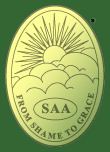Founded 1977 | ||
 | ||
Similar Sex and Love Addicts A, Emotions Anonymous, Gamblers Anonymous, Co‑Dependents Anonymous, Alcoholics Anonymous | ||
Sex addicts anonymous
Sex Addicts Anonymous (SAA) is a twelve-step program for people who want to stop their addictive sexual behavior. There also exists an auxiliary group known as COSA, for friends and family members of SAA members, similar to the role Al-Anon for friends and family members of Alcoholics Anonymous.
Contents
- Sex addicts anonymous
- Sex addicts anonymous and thanks for sharing
- Introduction
- Meetings
- Sponsors
- COSA
- References
Sex addicts anonymous and thanks for sharing
Introduction
SAA was founded in 1977 by several men who wanted a greater sense of anonymity than what they perceived in other twelve step programs for sex addicts. SAA is open to anyone who desires greater control over their behavior, and is intended to be safe for people of all sexual orientations.
Some SAA groups screen new members before giving them meetings times or locations. Any group that uses a questionnaire or screening before allowing membership is not a true SAA group. The 3rd tradition clearly states that "The only requirement for SAA membership is a desire to stop addictive sexual behavior". Anyone that walks through the doors to an SAA meeting will be allowed participation regardless of their reason for attending whether it be legal, or fear of losing a spouse/partner/boyfriend/girlfriend, or just a life that is out of control. Sex Addicts Anonymous does not have any approved questionnaires nor do they condone use of any questionnaire prior to membership. There is a specific questionnaire that can be used to determine if a potential member is likely a sex addict, but none of the groups require a certain score in order to attend. Generally the questionnaire is used as a personal self-assessment This questionnaire, with slight modifications so that it could be used experimentally, was able to correctly differentiate self-identified sex addicts and court-determined sex offenders from a control group. When completing the questionnaire males more often perceive themselves as sexually compulsive, but score lower (show less signs of sexual addiction), on average, than females.
In SAA each member creates a unique definition of "sexual sobriety" based on abstaining from a personalized list of compulsive sexual behaviors. Members are encouraged to respect each other's definitions of sobriety. Many SAA members use a "three circle" concept to model their behaviors. The inner circle represents the compulsive sexual behaviors that must not be practiced. Inner circle behaviors might include having sex with a prostitute, or acting out with a nonconsensual victim. The outer circle includes sexual and nonsexual behaviors that are definitely healthy. Outer circle behaviors might include sex with a partner in a monogamous relationship or getting eight hours of sleep a night. In the middle circle are behaviors that are not considered a relapse (inner circle behaviors), but could quickly lead to one if left unchecked. Middle circle behaviors might include looking for a prostitute or contacting an old acting out partner.
In addition to regular meetings SAA also organizes "boundary meetings." These are special meetings for professional caregivers such as medical doctors, psychotherapists, and clergy who need to attend meetings separate from clients, patients, and parishioners.
Some SAA members (a minority) may have a history of sexual abuse during their childhood, and more substance abuse problems than control groups. SAA publishes the book Sex Addicts Anonymous. It is widely used in SAA and has been officially approved as their basic text by the ISO of SAA, Inc Literature Committee. It has gained the approval of the annual conference of group delegates.
Meetings
Several types of meetings are offered at SAA: in-person meetings, telemeetings, and online meetings. Meetings can be mixed (meaning both men and women attend) or gender-specific (men-only meetings vs. women-only meetings). Meetings that are advertised as closed are “open only to those individuals who have a desire to stop their addictive behavior"; in contrast, open meetings are “open to anyone interested in…SAA,” regardless of whether the individual has expressed a desire to change. Additionally, telemeetings, or meetings via conference calls, and internet-based meetings are sources of real-time support outside of the traditional in-person meeting. In the United States, SAA meetings are held in all fifty states as well as the District of Columbia and Puerto Rico.
Sponsors
A sponsor is a member that has been part of the program for a large period of time and has attained a desirable level of sex sobriety. These individuals will help new members by offering a more personal level of availability in order to answer questions when needed. Usually, newcomers will find a proper sponsor after attending a few meetings taking in consideration the level of comfort between the new member and the old one, but if a good relationship is attained, the new attendee will continue to be guided by this person.
COSA
COSA is a recovery program for family or friends whose lives have been affected by someone else's compulsive sexual behavior. The official name of the organization is the acronym COSA; it is no longer the abbreviation C.O.S.A. as there was no agreement that it stood for either 'Codependents of Sex Addicts' or 'Co-Sex Addicts'. Each COSA member may choose to define him/herself as a codependent of sexual addiction, as a co-sex addict, or simply as a member of COSA, according to his or her own personal experience and conscience.
